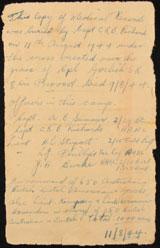Stolen Years: Australian prisoners of war - Witnesses
If any of us get out of here this atrocity must be reported.
Captain Rod Jeffrey on witnessing the death of Gunner Albert Cleary at Ranau, March 1945Captain Rod Jeffrey on witnessing the death of Gunner Albert Cleary at Ranau, March 1945
Prisoners had a fierce desire to live, and to make sure that even if they did not, their story would survive. Many kept diaries, invariably written in secret, often in minute writing. Discovery often meant punishment, even death.
Why did men and women go to such lengths to record their experiences? To record was a kind of resistance: to document was a kind of memorial. They made sure that even if they died, their writings, made on the backs of cigarette packets, on scraps and sheets of all kinds, would constitute a testament to what prisoners had endured and survived.
Today, those writings form the key evidence for our understanding of the prisoners’ experience.

Japanese survey photo group
Japanese soldiers also felt the need to record the war. These images, taken on the Burma–Thailand Railway, most probably by a member of a Japanese film crew, must have first been intended as a record of achievement and service. In the 1970s, a member of a Japanese veterans’ tour gave prints from the original footage to an Australian ex-prisoner of war when they met by chance in Thailand. The photographs are now further evidence of what the men endured.